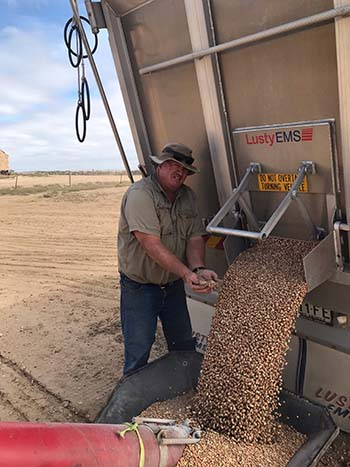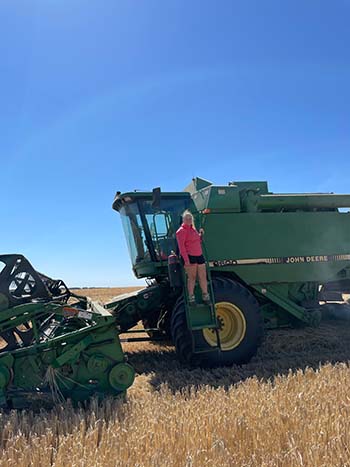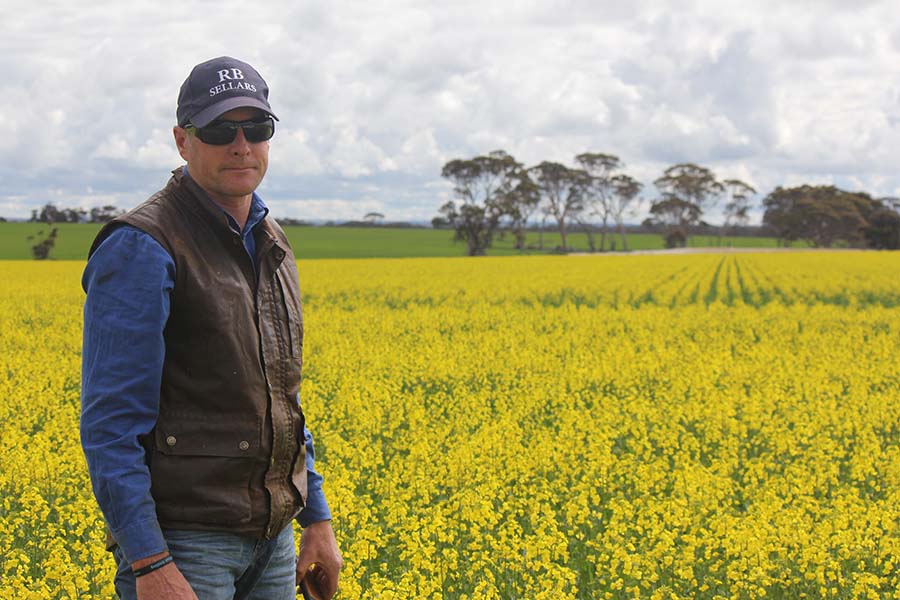During last season’s harvest, these growers all struggled to get the most out of their harvest. With lessons learnt in the backs of their minds, this harvest they’ve kicked off with some improvements that will surely increase their yield and output.
Tim Harvey, Hartley, South Australia
 Hartley grower, Tim Harvey during the 2020 harvest.
Hartley grower, Tim Harvey during the 2020 harvest.
A change in harvester brand for the first time in 28 years was some of the motivation for the Harvey family from Hartley to attend a GRDC harvester forum in Moorlands, South Australia, prior to the 2020 harvest.
Tim Harvey, his brother David and father Robin, went on a steep learning curve prior to their harvest program, to understand the workings of their newly purchased low-hour used machine, while at the same time attempting to minimize grain losses.
“We ran New Holland rotary machines for 28 years, so it was a change to move to a single rotor Case harvester,” Tim says.
“At the start of harvest, we could see a fair bit of canola being thrown out the back of the header, so we knew we had to make some adjustments.”
The Harveys have direct headed canola since 2017, desiccating the crop two or three weeks prior to harvest.
“At the start of harvest our canola losses were up to almost 10% which was unacceptable and a big dollar loss out the back of the machine,” Tim says.
“It took us one or two days of playing around with different settings to get these losses right down, while also being mindful of not losing too much harvesting time.”
The Harveys felt a two per cent loss was an acceptable target and one they were happy to live with given the time involved in getting the correct set up for their conditions.
To reduce grain loss percentages, the Harveys increased their rotor speed, opened up the concave and reduced the revolutions per minute (RPMs) on the straw spreader.
Tim says he noticed the higher RPMs sucked the canola away from the top sieve, something he hadn’t seen using his previous machine.
“Since we use a woven mesh on both the top sieve and also the pre-sieve with chains for removal of snails, we had to consider the impact that was having in regard to harvest losses,” Tim says.
“We noticed where the chains were running longways down the sieve, it stayed cleaner, with less trash but where the chains were running across the sieve, there was more trash, meaning greater losses out the back.”
Cropping 2500 hectares annually, canola forms only a part of the Harvey’s legume-based rotation, along with a self-replacing Merino flock.
However, with canola prices around $600/t, any sizeable grain loss in the paddock was a significant loss to the business.
To measure losses, the Harveys invested in a Bushel Plus System which included a remote magnetic drop tray, air separator and scales.
“Before purchasing the Bushel Plus system, it was difficult to gauge our losses accurately,” Tim says.
“We could see the grain in the chaff trial, and we were forever attempting to calculate these losses. The drop tray system is faster and significantly more accurate,” Tim says.
“It was an excellent investment, and we are very glad we took the time to use this system and measure losses properly,” Tim says.
Two brands of mechanical seed destructors were on show at Moorlands and the Harveys plan to invest in the technology in the near future.
“Brome grass and ryegrass are our two biggest headaches, so we need to look at different ways to attack those weeds, with less reliance on herbicides,” Tim says.
Ray Harrington, Darkan, Western Australia
Bringing harvest grain losses down under one percent was something agricultural identity and Darkan farmer Ray Harrington always aspired to.
As is the case with most agricultural engineering solutions, all it took was some thinking ‘outside the box’ to re-adjust the internal workings of a rotary harvester to work more like a conventional harvester, and grain losses on the Harrington’s farm became almost non-existent.
Ray attended a GRDC harvester forum, run by Primary Sales, in Kojonup just before the 2020 harvest, and was inspired by the thinking of presenter Brett Asphar, from Seed Terminator, on the adjustments needed to reduce losses, particularly in Case harvesters.
In the internal workings of Ray’s harvester, a pinch point created a king hit or ‘punch’ style threshing which caused grain to crack and left heads unthreshed, particularly evident in his lupin crop.
“What Brett said about rearranging the concave and changing the threshing pressure made a lot of sense to me, so I followed up with him after the presentation to get further instruction,” Ray says.
Brett eventually visited Ray on-farm and adjusted the concave, taking away the pinch point, allowing for a longer, lighter threshing process.
“In hindsight, it was common sense, but I needed Brett to work it out in the beginning,” Ray says.
Instead of that king hit threshing style that comes from having a pinch point, the more open concave which has uniform space flowing right around the rotor, allows for a “massage-style”, or longer, softer thresh.
This softer process not only reduces grain losses but also has positive impacts on fuel consumption and machine longevity.
“We have really noticed the difference, particularly in canola,” Ray says.
“We no longer get those awful hard-working sounds coming from the machine. Any process that is softer and smoother when it comes to the combination of steel and fuel is better for business in my opinion.”
Ray admits he doesn’t know exactly what percentage of grain he was losing before the adjustments were made, but he says for the first time in the post-harvest summer period, and after a 100 mm of summer rain, he has seen significantly less volunteer growth in the paddocks.
“We only received our Bushel Plus drop tray system at the end of harvest, but when we were measuring the losses after Brett had come to the farm and made all the adjustments, we were seeing numbers like 0.04 percent losses – they were almost non-existent,” he says.
Ray believes the biggest change has been the consistency in threshing styles across all crops, with almost no requirement to constantly adjust settings for different grains, weather conditions or time of day.
Known for inventing the Harrington Seed Destructor, now the iHSD, Ray also recently designed an automatic door on the back of the iHSD to allow for the remote dropping of a grain measuring tray.
Now, from the comfort of the harvester seat, the driver can open the automatic door and release the drop tray – all in just a few seconds.
“With the iHSD, using a drop tray was a more involved process, but now it’s easy and simply means we can measure our losses more seamlessly throughout the harvesting day,” Ray says.
Chelsea Hassell, Pingelly, Western Australia
 Chelsea Hassell during the 2020 harvest. Image: Jo Fulwood
Chelsea Hassell during the 2020 harvest. Image: Jo Fulwood
A well below average production year for canola was the catalyst for Chelsea Hassell and her dad John to urgently put in place strategies to minimise grain losses for their 2020 harvest.
“During the 2019 harvest I could see we were losing too much grain from the back of the header, and I wanted to improve the way we went about harvest for the 2020 season,” Chelsea says.
The Hassell’s run a mixed cropping and livestock business in Pingelly, and in 2020 had 1000 hectares planted to canola, barley, oats, and lupins.
Canola makes up the biggest percentage of their cropping program, and with a below average yield in 2020, Chelsea says the focus was on harvesting as much grain as possible.
“We had a few teething issues with our seeding system last year, so even a small amount of grain loss added up to a fairly large percentage of the total production,” Chelsea says.
Attending a GRDC Harvester Forum in Cuballing in September, run by Primary Sales, Chelsea says she discovered new ways to accurately measure the preventable grain losses out of the harvester.
“Initially I didn’t think I would get much value from the forum because we generally bale the straw from wind rows behind the harvester for sheep feed, so I didn’t know how we could accurately measure our grain losses,” Chelsea says.
“But it was excellent to go along and talk to other growers and see how they had set up their systems.”
After attending the forum, Chelsea convinced her father of the need to accurately measure losses with a Bushel Plus drop tray system.
In her early measurements using the drop tray system, canola grain losses were around 10 per cent.
“We went about the harvester set up changes in a step-by-step way, so we could see at each stage what the impact on the losses would be,” Chelsea says.
“We changed three things, which in the end bought the canola losses right down to just one per cent,” Chelsea says.
With help from the team at Primary Sales, the first changes made was to the spacing and levels of the sieves.
“Changing the settings on our harvester is a manual process, none of the settings are run on a computer system,” Chelsea says.
“To the naked eye, it looked to us as though the sieves at the back of the machine were level, but when we physically measured the distance between them, they weren’t level, so this was obviously having an impact on the way the grain was being pushing through the machine.”
This simple adjustment bought the losses down to six percent.
Secondly, the Hassells increased the fan speed, and lastly, they decreased the rotor speed.
“When we changed this last setting, we had reduced our losses right down to one percent, all in the space of just three hours, which resulted in a massive saving to the business” Chelsea says.
In their lupin crop, the Hassells dropped the fan speed and increased the rotor speed only slightly to see a drop in loss percentages from 9.5 down to 3.5.
Likewise, in barley, they reduced their losses, albeit only marginally, from 1.75 per cent to 1.62 per cent.
Needless to say, both John and Chelsea are now fully convinced of the value of accurately measuring losses with the right equipment and making the right adjustments to keep more of their grain in the bin.
Ty Kirby, Nyabing, Western Australia
Nyabing grower Ty Kirby stands in his canola crop. Image: Rachel Kirby
Nyabing grower Ty Kirby attended a GRDC Harvester Forum in Kojonup, run by Primary Sales just prior to the 2020 harvest season, with the intention of understanding how to reduce the number of harvest weed seeds coming out of the back of his older Case harvester.
But what he ultimately gained from attending the forum was a better understanding of how to reduce his lupin losses through an improved front set up on his new John Deere harvester.
“In 2019 we put an iHSD in the John Deere harvester, but we were still chaff lining with our Case machine, and I wanted to see what could be done to the settings of the Case to reduce the weed seeds being spread back out over the paddock,” Ty says.
While the chaff lining was making an impact, there was still a significant weed problem in the tramlines, meaning seeds were going through the machine and out the back.
After the workshop, Ty shifted the concave cage to increase the pinch point area, in an attempt to reduce the loading on the sieves.
“Most headers overload the sieves on the left hand side because the pinch point is at the bottom, but if you can shift the concave to the right hand side of the machine, so it moves the pinch point to a bigger area closer to the bottom left hand side of the concave, and the grain is then exiting the rotor through to the right and therefore not overloading sieves,” Ty says.
“You then have better capacity to maximize the seed capture, provided you have all the other settings correct.”
Despite spending this time on the Case machine, Ty’s business changed over to a second John Deere harvester just before harvest began.
“What we learnt from the Harvester Workshop was that there wasn’t too much that we could easily tweak in the John Deere machine,” Ty says.
Both John Deere machines were set up to the default settings, with the original choke guards on the fronts.
“I left both machines like that, and when I started harvesting, I could see we were getting losses at the front with the grain falling forward or shattering before it even went into the machine, but at that point in the time I hadn’t measured these losses,” he says.
Convinced to purchase a Bushel Plus System, Ty used the drop tray in front of the harvester, and discovered he was losing up to 400 kg per hectare of lupin seed onto the paddock floor.
“It was easy to do the sums,” Ty says.
“If we were losing 400 kg/ha over 600ha of lupins, we were potentially going to be losing up to $100,000 worth of lupins. Even if we could reduce that by half, it was worth making changes to the front end.”
Adding a set of Primary Sales knife guards and large plastic finger extensions helped Ty resolve this problem.
He says measurements from the Bushel Plus system at the back of the header, in wheat, barley, canola and lupins showed there were only minimal losses.
“We had been following the @harvestloss thread on twitter and so we were able to watch what other farmers had been doing in the northern parts of the grain belt earlier in the season, before we even started our harvest,” Ty says.
“As such, our losses out the back were acceptable when it came to our later harvest start.”
More information: Correct harvester set-up yields results: GRDC workshops; Improving harvester set-up ‘money in the bank’: grower and Harvest resources.


























































